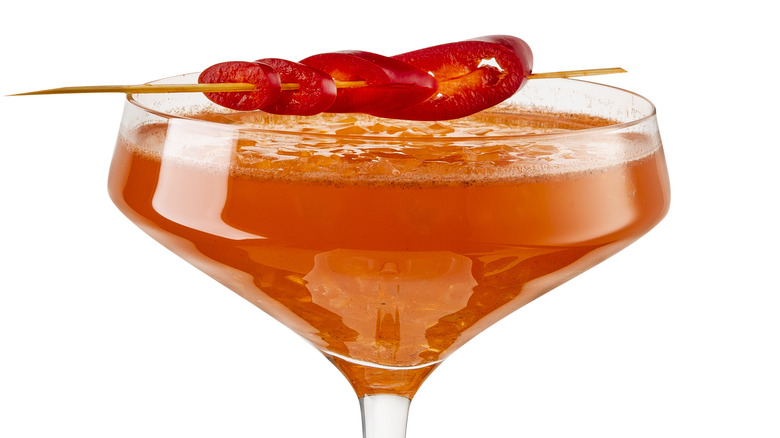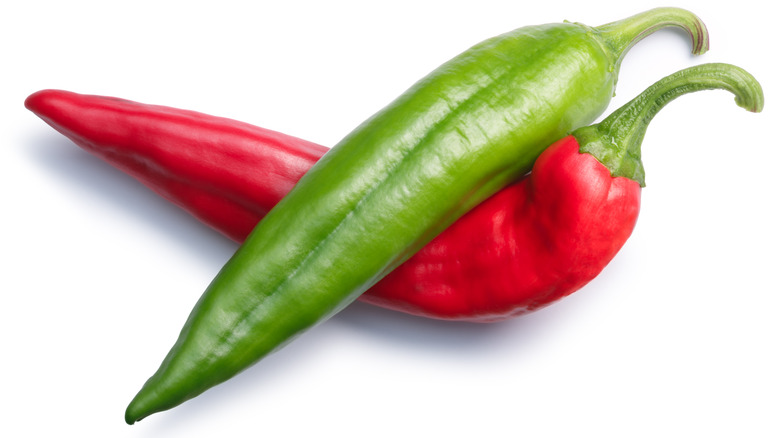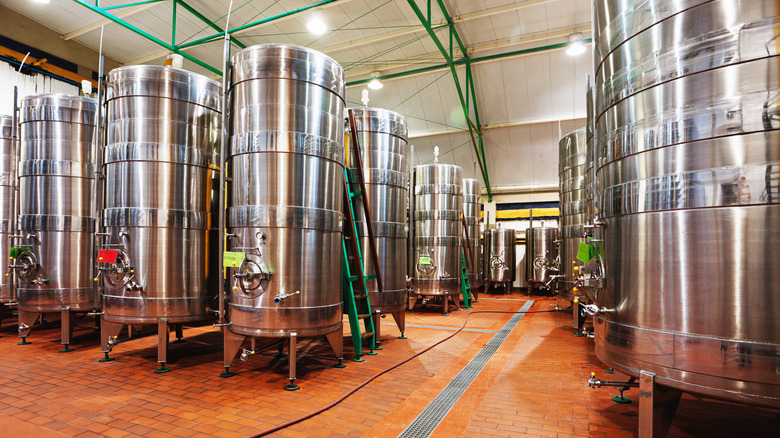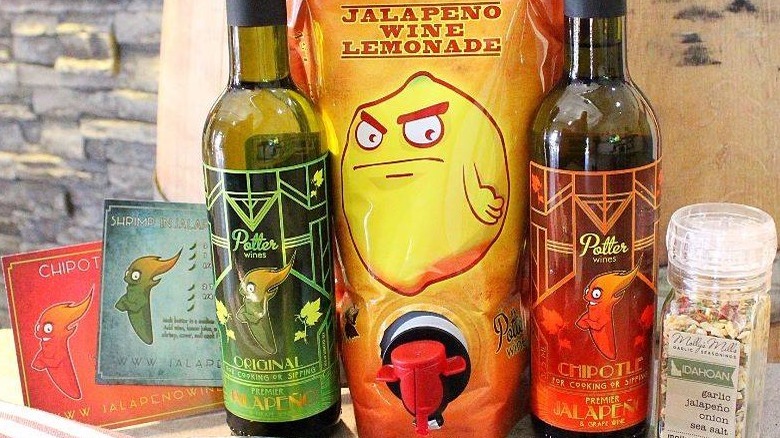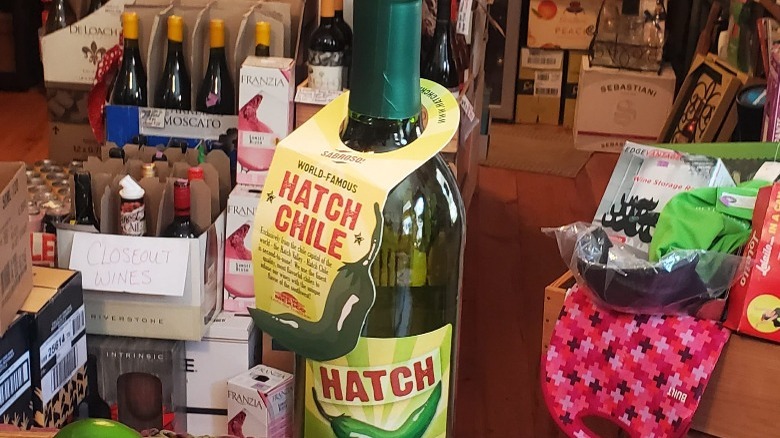Yes, You Can Buy Spicy Wine (If You Can Handle The Heat)
When oenophiles describe a wine's flavor notes, they may trot out a whole range of comparisons that could seem odd to anyone a bit less obsessed with the subject, likening the taste to grapefruit, tobacco, boiled eggs, or wet gravel (we're not kidding about any of these descriptions as they can all be found on a wine flavor wheel). Frequently they'll speak of "peppery" notes, which in most wines are the result of a chemical known as rotundone. That flavor in wine is actually pretty popular, and as far back as ancient Rome, people would sometimes add pepper and other spices to their goblets to produce peppery notes in a very literal way. More recently, however, winemakers have been upping the ante – and the heat level – by introducing chile peppers into the wine-making process.
While chile pepper-infused wines have long been used in Chinese cooking, ones meant for drinking are a popular product in the Southwestern U.S. where they make for a fun souvenir for tourists to bring back from chile-growing country (which is to say, anywhere from Pueblo, Colorado to Hatch, New Mexico and points in between). Are such wines just a novelty, though, or are they something you might actually enjoy drinking? Well, that all depends on the wine, but as chile-infused wines seem to be growing in popularity, there are now a number of different types from which to pick if you're partial to peppers.
What types of chiles are used in spicy wine?
Chile wines are made with several different types of peppers, all of which vary in heat levels. One particularly prominent type of chile wine is made with green Hatch chiles, which are, exactly as the name implies, green chile peppers grown in Hatch, New Mexico, the state-proclaimed Chile Capital of the World. Hatch chiles don't tend to be all that incendiary, as most range between 1,500 and 2,500 Scoville units. This means they're about as hot as your typical Anaheim or poblano pepper. When the same peppers are left to ripen longer, they become red Hatch chiles, which are sometimes used to make wine, as well. These red counterparts are said to taste sharper, although they're typically used in dried form. They can also be milder, with some coming in as low as 500 Scovilles (this is about as hot as pepperoncini, which is to say, not very).
Other peppers besides Hatch ones can also be used in winemaking. Chimayo red chile wine is a thing, with these peppers being a bit hotter at 4000+ Scovilles. Jalapeños, too, are sometimes used to infuse booze (including wine), and some winemakers will also include serranos or chipotles in the mix.
How is spicy wine made?
There are a number of different ways to infuse wines with chile flavor, but not all of these seem to be as effective as others. Rob McDonald, the proprietor of California's Art+Farm winery, told Wine Spectator that he originally tried adding chopped jalapenos to the fermenting vat, but found the resulting wine to be lacking in any kind of chile flavor. He then switched to adding both jalapeños and habañeros to the stainless steel tanks where the wine was finishing up and found that this worked better to create the kind of spicy wine he'd envisioned – while he's tried this with different types of wine, his preference is for using sauvignon blanc.
Other wineries also use the infusion method, which typically takes several weeks in order to procure the proper pepper proportion. There are some wineries, however, that do still ferment chile peppers along with wine grapes. One New Hampshire-based winery, Copper Beech, even goes so far as to forego the grapes altogether and ferment its Caliente wine from nothing more than jalapeños, yeast, sugar, and water.
What are some types of spicy wine?
Copper Beech's jalapeño-based Caliente is so popular it's been known to sell out and in 2017 it won a bronze medal at the second annual Drink Outside the Grape competition celebrating fruit wines, meads, ciders, and fruit brandies. Other jalapeño wines include ones from New Hampshire's LaBelle Winery, Illinois' Galena Cellars, and Idaho's Potter Winery (this last-named establishment offers both original and lemonade varieties). California-based Art + Farm also offers its jalapeño and habañero-infused Hath No Fury.
Two types of Hatch chile wines are produced by New Mexico's D.H. Lescombes winery: white with roasted green chiles and red with red chiles. Noisy Water Winery, also in New Mexico, makes a green chile white wine called Besito Caliente as well as a chimayo-infused red wine known as Rojo Caliente. Colorado's Songbird Cellars, alas, appears to be out of business, so it won't be making any more of its Pueblo chile wine. You can, however, still get cabañero (cabernet + habañero) from a California winery of the same name.
Chile mead (aka capsicumel) is also a thing. Chicago's Wild Blossom Meadery & Winery makes a kind called Pirate's Blood which is made with three types of (unspecified) peppers and comes in a cool skull-shaped bottle. Helderberg Meadworks in upstate New York also makes a mixed-pepper mead simply called "Hot Pepper Mead," While the bottle, too, is on the plain side, the label does depict a sword-wielding Viking.
What does spicy wine taste like?
While we admit we haven't tried all of the wines we've just listed (though we're certainly hoping to have the opportunity someday), we'd bet that there's quite a bit of variability between them all. None of the wines, however, seem to have melt-your-face-off levels of heat. Cabañero's Roaring, Rowdy, & Robust Red may be one of the hottest, and also the driest, of the chile-based wines currently available, but while an Esquire review found it to have a nice little kick to it, the heat level was described as fairly moderate while the wine was a typical red blend (in addition to the cabernet grapes, it also includes syrah and petite verdot.)
Hatch Green Chile Wine (presumably the kind bottled by D.H. Lescombes, as it is sold under this name) provides quite a different taste experience, however. The winery itself markets the stuff as "semi-sweet" and only "slightly spicy" and a reviewer with The News & Observer out of Raleigh, North Carolina found the pepper flavor to be noticeable, but not at all hot, while they felt that the wine itself tasted similar to a riesling (which is appropriate since this type of white wine is often paired with spicy foods). Total Wine reviewers seemed to agree with the assessment that this wine is pretty sweet with just a tiny bit of heat, but overall they found it surprisingly enjoyable, enough so to warrant a 4.8-star rating.
Where to buy spicy wine
All of the wineries we've mentioned here do seem to sell their chile wines onsite, so if you are willing to go on a road trip, you can sample to your heart's content and provide a definitive account of how each compares to the other. Not all of them, however, are able to ship these wines; nor do they necessarily have a large distribution network. So when it comes to purchasing chile wines in bars, restaurants, and liquor stores, you probably stand a better chance if you're located in a southwestern state. If you're visiting the Total Wine located in Santa Fe, New Mexico, you may purchase both red and green varieties of Hatch chile wine in-store. Should you be shopping the Total Wine in Greenfield, Wisconsin, instead, no chile pepper wines are available for purchase (at least not at the time of writing).
What about purchasing spicy wines online, though? D.H. Lescombes does sell its Hatch chile wines through its website, although any possible purchase is pending permission of your state or local authorities as some locations limit online alcohol sales. Noisy Water Winery, LaBelle Winery, Galena Cellars, Potter Winery, and Art + Farm also offer online sales, as do Wild Blossom Meadery & Winery and Helderberg Meadworks. Copper Beech Winery, however, is not set up to sell its wares online, nor is Cabañero WInes, although you can buy the latter's Roaring, Rowdy, & Robust Red at the Texas grocery chain H-E-B.
